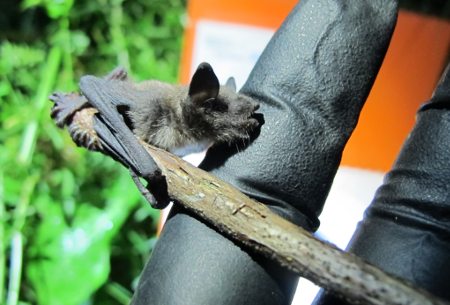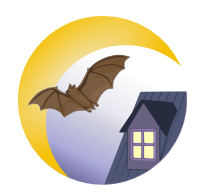Fall: Reproduction/Migration
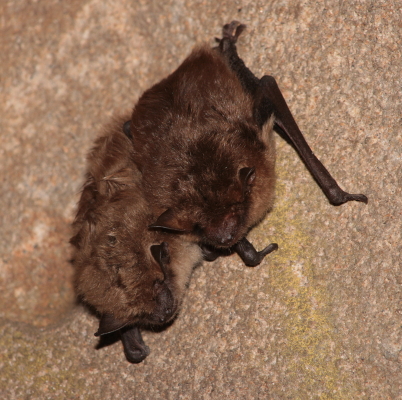
In the fall, just prior to hibernation, bats can be seen flying in large numbers usually near the entrances of hibernacula. This congregation of bats is called “swarming” and this is generally when mating occurs. Swarming is a unique event during the life-history of bats because it is one of the rare occasions when a large number of bats can be found in a single area. At swarming sites, males can be observed courting females to mate with. Females also spend time with their young at this time, demonstrating that swarming sites also represent places of learning for the young bats. Since swarming sites can be visited by hundreds of individuals in one night, they ensure a high copulation rate. This is an advantageous reproductive strategy because it increases genetic diversity. As a result, some scientists believe that swarming is essential for the persistence of diverse populations. Sadly, this behaviour could be contributing to the propagation of white-nose syndrome
The reproductive period is the best season for determining the sex of bats because male reproductive organs can be easily observed. Mating in different species occurs after a courting ritual that involves either singing or chasing one another. Suspended by his hind paws, the male embraces the female in his arms and climbs on her back. To avoid losing his grip, the male bites the skin at the nape of the female’s neck. The partners remain united for several minutes.
Winter: Hibernation
Between October and November, cave-dwelling bats begin making their way to their hibernation roosts, while migratory bats leave Canada and travel to their wintering grounds in the Central and Southern United States. Some, such as the red bat (Lasiurus borealis) will travel as far as Mexico and the hoary bat (Lasiurus cinereus) travels all the way to the Carribean.
The roosts where bats hibernate are called hibernacula. They are usually located in crevasses, caves or abandoned mines. The big brown bat will sometimes hibernate in human dwellings as well. A desirable hibernacula for bats has a high humidity with a temperature slightly above freezing. Some species hibernate in small groups, whereas others hibernate alone.
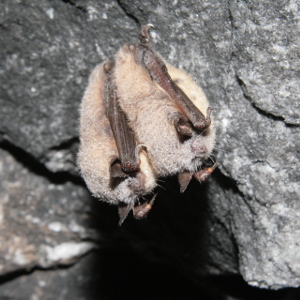
During hibernation, the heart rate of bats decreases to about 25 beats per minute (bpm) (a normal active heart rate is 400-1000 bpm when active) and their body temperature decreases from 36°C to 3-6°C. Bats are able to survive cold winters because of these physiological adaptations and because of fat reserves that can account for up to 35% of their weight. Bats will come out of torpor about once a month (every 12-30 days) to urinate and rehydrate. Waking up from torpor requires a large amount of energy since they must warm their body temperature from just above freezing to 36°C in a very short amount of time. A single arousal can consume fat reserves that represent the energy required for 30-60 days of hibernation. Entering hibernacula during the winter should be avoided to prevent bats from arousing from hibernation. Noise, light and heat can easily disturb them (Biodôme de Montréal et Metro Toronto Zoo, 1997).
For several years now, the hibernation of bats has been disturbed by a fungus that has become widespread across many hibernacula. It causes bats to wake up more often than normal and thereby increases their energy expenditure. Bats affected by this fungus can be recognized by the presence of white spots on their wings and faces, giving the name white-nose syndrome to this “infection”.
Spring: Gestation
During the winter, sperm is kept viable in the female’s uterus. After bats come out of hibernation in April, females ovulate and fertilizations occurs. This phenomenon is called delayed ovulation.
Gestation varies depending on the species, as well as the food availability and ambient temperature. Colder temperatures will delay the development of offspring. The gestation period of Canadian bats can be as short as 40 days (Keen’s myotis and the long-eared bat) or be as long as 100 days (Townsend’s big-eared bat).
Coming out of hibernation, bats are on the hunt for food, having exhausted almost all of their fat reserves. Climatic conditions in the spring are therefore crucial, as they dictate the emergence of insects, which the bats need as an immediate source of food. This is even more important for pregnant females who need all of their strength before they give birth to young. As a result, they must coordinate their exit from hibernation with the emergence of insects. In some species, males exit hibernacula slightly later than females.
Summer: Birth and raising young
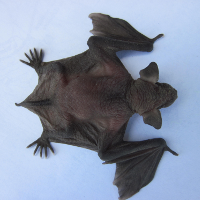
Females give birth to one or two young (but sometimes as many as four in the case of the red bat). In most species, the females have two nipples, but those with larger litters may have more. In some species, the females will form small colonies to give birth, and raise their offspring, called maternity colonies. They will return to these colonies each year. When it is time to give birth, some females will position themselves upright. The newborn comes out feet first and is caught by the female’s uropatagium. In other species, the female will position herself with her head facing down and give birth in this position. Once born, the new-born will cling to the fur of its mother and will remain there for several days.
At birth, juveniles do not have fur; their pink bodies are covered by a fine fuzz. Fur begins to appear between 4 and 14 days after birth. Their eyes open and ears unfold after just a few hours. Already, the young bat has about twenty temporary milk teeth. Like humans, their permanent teeth emerge later.
Nursing lasts 4-5 weeks. Since the mother’s milk is rich in energy, offspring grow rapidly. After the nursing period, the young are weaned and learn to fly. At this point they have reached adult size, but not adult weight. Young will stay with the adults until the end of the summer, learning where to find food and locate the best roosts. Depending on the species, the young will hibernate or migrate in the fall and winter.
